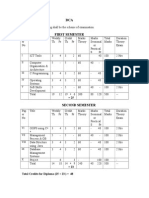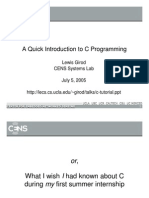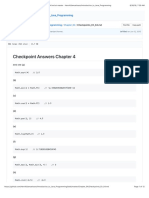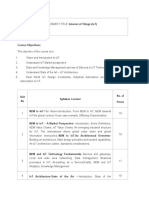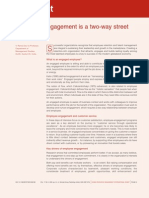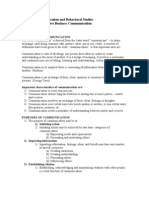Lecture Eight (Notes) - Documentation
Lecture Eight (Notes) - Documentation
Uploaded by
gdeepthiCopyright:
Available Formats
Lecture Eight (Notes) - Documentation
Lecture Eight (Notes) - Documentation
Uploaded by
gdeepthiOriginal Description:
Original Title
Copyright
Available Formats
Share this document
Did you find this document useful?
Is this content inappropriate?
Copyright:
Available Formats
Lecture Eight (Notes) - Documentation
Lecture Eight (Notes) - Documentation
Uploaded by
gdeepthiCopyright:
Available Formats
LECTURE EIGHT (NOTES) DOCUMENTATION
What these lecture notes co er! How to write good comments How to document code (a suggestion)
Lecture Eight (Notes) Documentation ...................................................................................................1 What these lecture notes cover:.............................................................................................................1 Documenting code.................................................................................................................................1 Commenting code well..........................................................................................................................1 !adl" commented #iece o$ code.........................................................................................................1 well commented #iece o$ code...........................................................................................................% E&ternal Documentation........................................................................................................................' (ser Documentation..............................................................................................................................) Docu"ent#n$ co%e n im#ortant #art o$ "our #ro*ect write u# will !e the #rogram documentation. +here are three se#arate #arts to code documentation: 1) +he comments "ou #ut in "our code. (internal documentation) ,) What "ou write a!out "our code to e&#lain how it wor-s to a #rogrammer who will !e wor-ing on e&#anding "our code. (e&ternal documentation) .) What "ou write a!out "our code to e&#lain how it wor-s to a user who will !e using "our #rogram (user documentation) Each o$ these three t"#es o$ documentation re/uires its own a##roach. Co""ent#n$ co%e &ell Comments are eas" to #ut in code and almost ever" #rogrammer realises that the" should #ut comments in code !ut almost no #rogrammers do it well. 0ou should consider the $ollowing with each comment: a) Will it hel# the reader understand the code or !) m 1 *ust adding a comment here !ecause 1 thin- 1 should add a comment as- "oursel$ 21s this something that the reader could have triviall" wor-ed out $or themselves2 Comments are good !ut sometimes less is more. Consider: i= i+1; /* Adds one to i */ 1$ something is #articularl" tric-" then re$er to a re$erence rather than e&#lain it in comment: void very_complicated_sort (int array[]) /* Sorts the array into increasing n meric order ! see "n th #$ery complicated programming% p1&'(1&& )or details */ +he ne&t #age shows a !ad set o$ comments the code #rints #art o$ the 3eigen!aum diagram $rom coursewor-. A 'a%l( co""ente% )#ece o* co%e *incl de +stdio,h-
*incl de +stdli.,h*incl de +math,h/* /ichard0s chaos program */ /* 1rototypes */ void 2rite_3d_array (char []4 int4 )loat []4 )loat []); /* 5n ms and *de)ines */ en m 6 We could tell 7A819:;<S= &''''4 this an"wa" /5S9=><:9;= 1''' without the ?; comment *de)ine 9><@:=5 Achaos3,o tA int main() /* main ro tine */ 6 /* Be)ine some varia.les */ )loat Cpts[7A819:;<S]4 ypts[7A819:;<S]; +his seems int tot_points; sill" !ut 14ve )loat C4lam.da; seen this )loat D[/5S9=><:9;]; comment so int Dval; man" times int i4E; tot_points= '; )or (i= '; i + /5S9=><:9;; i++) 6 /* <ricFy .it */ lam.da= ',G&+ (',3&*()loat)i / (/5S9=><:9;(1)); )or (E= '; E + /5S9=><:9;; E++) 6 D[E]= '; ? C= ',HI&J; )or (E= '; E + &'; E++) 6 /* Bo this )or every E*/ ? )or (E= &'; E + 1&'; E++) 6 /* =ong ram.ling comment 2hich doesn0t )inish C= I*lam.da*C*(1,' ( C); Dval= (int) (C* (/5S9=><:9;(1)); i) (Dval -= /5S9=><:9;) Dval= /5S9=><:9;(1; Comments "ou i) (D[Dval] == ') 6 must scroll to read D[Dval]= 1; Cpts[tot_points]= lam.da; are ver" ver" ypts[tot_points]= C; anno"ing tot_points++; i) (tot_points == 7A819:;<S) 6 print) (A<oo many points to plotKnA); ret rn (1; ? ? ? ? 2rite_3d_array (9><@:=54 tot_points4 Cpts4 ypts); ret rn '; /* 5nd o) main */
void 2rite_3d_array (char )ilename []4 int no_points4 )loat CaCis[]4 )loat yaCis[]) /* Lrite a 3 dimensional array */ 6 @:=5 *)ptr; /*@ile pointer */ int i; /* >sed in )or loop */ )ptr= )open ()ilename4 A2A); /* 9pen the )ile */ i) ()ptr == ;>==) 6
)print) (stderr4 A>na.le to open KAMsKA to 2riteKnA4 )ilename); eCit ((1);
)or (i= '; i + no_points; i++) 6 /* =oop over i */ )print) ()ptr4 AM) M)KnA4 CaCis[i]4 yaCis[i]); ? )close()ptr); /* Nlose it */ C= I*lam.da*C*(1,' ( C);
+he author o$ this #rogram has managed to #ut in a lot o$ comments without actuall" an" o$ them !eing hel#$ul (e&ce#t5 #erha#s5 to a non C #rogrammer and a non6#rogrammer isn4t going to !e $i&ing "our code 1 would ho#e). What should we comment7 s 1 guideline5 1 would alwa"s comment:
a) 8aria!les unless the" are o!vious $or e&am#le no need to sa" that i5* or - are varia!les used in loo#s the" almost alwa"s are. No need to comment that @:=5 *)ptr is a $ile #ointer. 9n the other hand int total might total u# an"thing and could #erha#s use some clari$"ing. !) 1 would alwa"s tr" to #ut in a comment at the !eginning o$ a $unction to sa" what that $unction does5 what it returns and when it !rea-s. int )actorial (int n) /* /et rn the )actorial o) n, n m.er */ 6 , , , ? <his 2ill .reaF i) passed a negative
int 2rite_3d_array (char )ilename[]4 int no_points4 )loat CaCis[]4 )loat yaCis[]) /* Lrites a 3d array to the )ile speci)ied .y )ilename in a )ormat s ita.le )or 7aple plotting, CaCis and yaCis are the t2o dimensions to .e plotted 2ith no_points in each, <he ) nction ret rns ' i) it is s ccess) l or !1 i) there is a pro.lem 2riting to the )ile */ 0our comment need not !e /uite so ver!ose as this !ut should give an idea what each $unction does5 what arguments it ta-es and what it returns. c) 1 alwa"s tr" to #ut a smaller comment !" the #rotot"#e o$ each $unction which gives some descri#tion. +he reason is that when "ou write a large #rogram5 the #rotot"#es are all grou#ed together in a header $ile and it is easier to gain an understanding o$ the #rogram !" loo-ing at them. d) 1n multi#le $ile #rogramming 1 would #ut a comment in each $ile to sa" what #ur#ose it serves in the #rogram: )ileio,cO /* <his contains .asic )ile inp t/o tp t ) nctions )or reading and 2riting records in the payroll program */ e) :tructures are almost alwa"s worth a comment since these are li-el" to !e ver" im#ortant in "our #rogram. 9ther than these situations5 "ou must !e guided !" common sense. ;utting in too man" comments ma-es "our #rogram unreada!le and mess". ;utting in too $ew will leave it cr"#tic. good guide is to #ut a comment on an"thing which "ou would $ind con$using even i$ given a minute or two to loo- at it. 1$ what "ou are doing is unusual then it is as well to comment it as such. 3or e&am#le5 it is eas" to
!e con$used !" code that has a 1/(r*r*r) i$ the code is su##osed to deal with gravitation (normall" a 1<r,) so it is as well to comment that something unusual is going on. Even i$ "ou -now the code is correct5 a later user might !e con$used !" it (or even worse =correct> it to 1<r,). $inal rule is that i$ something is e&tremel" di$$icult to comment and "ou $ind "oursel$ s#ending $our or $ive lines going on a!out it then it4s almost certainl" worth #utting a re$erence to e&ternal documentation instead. 0ou should note that in the ?odel answers to coursewor- 1 have tried to comment a##ro#riatel" !ut erred on the side o$ ma-ing too man" comments !ecause the coursewor- model answers were written to !e understood !" learning #rogrammers. @enerall" "ou should write comments with the assum#tion that the readers will !e e&#erienced #rogrammers. Here is how "ou should comment the code $rom the a!ove e&am#le (the code !elow is5 i$ an"thing5 over commented $or most #rogrammersA tastes):
A &ell co""ente% )#ece o* co%e *incl de +stdio,h*incl de +stdli.,h*incl de +math,h/* @eigen.a m,c <his program plots a @eigen.a m diagram )rom the =ogistic map ! see4 )or eCampleO 1eitgen4 P rgens and Sa peO Nhaos and @ractals <he plotting is simpli)ied .y splitting the y(aCis into A.insA and recording 2hether or not a point )alls into each o) these A.insA and then plotting a point accordingly*/ void 2rite_3d_array (char []4 int4 )loat []4 )loat []); /* Lrite the contents o) t2o arrays to a )ile in a )ormat 2hich can .e plotted .y maple */ en m 6 7A819:;<S= &''''4 /5S9=><:9;= 1''' ?; /* 7aC, n m.er o) pts to .e plotted*/ /* ; m.er o) A.insA to split ['41] into */
*de)ine 9><@:=5 Achaos3,o tA int main() 6 /* Nalc late the )eigen.a m diagram .y looping aro nd each val e o) lam.da and calc late 2hich o) the A.insA contain points to plot */ )loat Cpts[7A819:;<S]4 ypts[7A819:;<S]; int tot_points; /* <he n m.er o) points act ally plotted*/ )loat C4lam.da; /* varia.les in the logistic eQ ation */ )loat D[/5S9=><:9;]; /* Rolds a temporary AsliceA o) the diagram )or a val e o) lam.da */ int Dval; /* Rolds the A.inA 2e are plotting in */ int i4E; tot_points= '; )or (i= '; i + /5S9=><:9;; i++) 6 /* lam.da is in the range [',G141,'] */ lam.da= ',G&+ (',3&*()loat)i / (/5S9=><:9;(1)); /* Nlear o t the D array ! in e))ect maFe s re all the A.insA .egin empty */ )or (E= '; E + /5S9=><:9;; E++) 6 D[E]= '; ? C= ',HI&J; /* C_' ! a randomly chosen start point */ /* SFip over the initial &' points .y iterating the map &' times */ )or (E= '; E + &'; E++) 6 C= I*lam.da*C*(1,' ( C); ? /* <he neCt 1'' points may .e plotted so iterate the map a ) rther 1'' times*/ )or (E= &'; E + 1&'; E++) 6 C= I*lam.da*C*(1,' ( C); /* Nalc late 2hich A.inA 2e are in */ Dval= (int) (C* (/5S9=><:9;(1)); i) (Dval -= /5S9=><:9;) /* NhecF it is in range */ Dval= /5S9=><:9;(1; /* i) this A.inA has not .een visited .e)ore then
? ? 2rite_3d_array (9><@:=54 tot_points4 Cpts4 ypts); ret rn ';
set it as visited and plot a point */ i) (D[Dval] == ') 6 D[Dval]= 1; Cpts[tot_points]= lam.da; ypts[tot_points]= C; tot_points++; i) (tot_points == 7A819:;<S) 6 print) (A<oo many points to plotKnA); ret rn (1; ? ?
void 2rite_3d_array (char )ilename []4 int no_points4 )loat CaCis[]4 )loat yaCis[]) /* Lrite the C and y points o) the graph to a )ile4 named in the string )ilename4 in a )ormat )or maple plotting C aCis and yaCis sho ld contain at least no_points pieces o) data, */ 6 @:=5 *)ptr; int i; )ptr= )open ()ilename4 A2A); i) ()ptr == ;>==) 6 )print) (stderr4 A>na.le to open KAMsKA to 2riteKnA4 )ilename); eCit ((1); ? /* Lrite all the points to the )ile*/ )or (i= '; i + no_points; i++) 6 )print) ()ptr4 AM) M)KnA4 CaCis[i]4 yaCis[i]); ? )close()ptr); ? E+ternal Docu"entat#on +he role o$ e&ternal documentation is to let another #rogrammer who will !e wor-ing on "our code understand what is going on and how he or she might modi$" "our code. 1t4s hard to give a general descri#tion o$ how to document code since ever" com#an" has its own standards $or this. 1n addition man" automatic documentation tools e&ist $or this #ur#ose. +his descri#tion is intended as a reasona!le wa" o$ documenting at the level re/uired $or "our #ro*ects rather than as a descri#tion o$ =!est #ractice> in the real world. Documentation must !e done at several levels: 1) Descri!e the !road #ur#ose o$ "our code what it is su##osed to achieve and how. Descri!e what $iles the #rogram needs to run and how it wor-s (in !rie$). +his section can !e /uite long in a com#le& #rogram. E&am#le:
'
+his tra$$ic simulation #rogram ta-es in#ut in the $orm o$ a =road networ-> (s#eci$"ing the la"out o$ a town4s road s"stem) and a =demand matri&> (s#eci$"ing the drivers who wish to use the networ-). +he networ- and the demand are s#eci$ied in in#ut $iles to the #rogram. +he structure o$ the in#ut and out#ut $iles is descri!ed in the user documentation. +he #rogram then simulates a da"4s travel on the road networ-s and #roduces out#ut into a results $ile. +he travel is simulated using an iterative #rocedure which.... (etc etc) ,) Descri!e the general =$low> o$ "our #rogram. +hat is5 how it wor-s as an algorithm i$ "ou4ve used #articular sorting routines $or e&am#le then descri!e which one. 9$ten this is clearer in a diagram $orm. E&am#le: +he main routine #er$orms the $ollowing tas-s: i) Cead in networ- $ile and demand $ile (e&it on errors). ii) ssign vehicles to the networ- $or a $irst iteration o$ the simulation. iii) ;ic- shortest routes $or the vehicles (uses Di*-stra4s algorithm see later descri#tion) assuming there will !e no congestion on the networiv) :imulate one da" o$ travel on the networ- (see section on =simulation methods>). v) (se the simulated congestion and travel times to #ic- new shortest #aths $or vehicles. vi) 1$ the vehicle routes have not =converged> (see section on =routing convergence>) then go to iv) vii) 9ut#ut results o$ the simulation (see section on =out#ut $ormats>) DNote that this is an e&am#le onl" and "ou need not use this $ormat5 sometimes something more li-e a traditional =$low chart> can !e ver" e$$ective.E .) Descri!e what =source modules> "our #rogram has i$ "ou have used multi#le $ile #rogramming. +hat is5 what .c## and .h $iles "ou have used and what the" each contain (a !rie$ list o$ the most im#ortant things in each $ile). E&am#le: netstr ct,h: +his header $ile contains t"#ede$4s relating to the structure o$ the road networ-. 1t de$ines the t"#es NE+W9CF and DE? ND which are structures re#resenting the to#olog" o$ the road structure and the demand which is a##lied to the networ-. roadsim,cpp: +his contains the main() $unction and the general control o$ the #rogram. sim late,cpp: +his contains the main simulation engine. +he most im#ortant $unctions are: calc_delay() which calculates the dela" e&#erienced at a #articular *unction t"#e. neCt_linF() which $inds the ne&t lin- $or a vehicle. ro te,cpp: +his contains route $inding algorithms: )ind_shortest(): calculates the shortest #ath through a networ-. . . . B) lmost an" struct<t"#ede$ used in "our code should !e descri!ed in the documentation unless it is #articularl" trivial. E&am#le: +he NE+W9CF structure descri!es the to#olog" o$ the networ- which the simulation is #er$ormed on. ?em!ers o$ the structure re#resent the *unctions and roads in the networ-. +he structure is de$ined in the $ile netstr ct,h
%) 3or each ma*or $unction descri!e what that $unction does5 what varia!les it ta-es and what it returns. +his is ver" similar to the comments made on ever" $unction on the internal documentation. Note that 1 have !een vague a!out what constitutes a =ma*or> $unction. 0our code $or this #ro*ect is li-el" to !e short enough that e&#laining ever" $unction won4t ta-e too long. ;a" #articular attention to descri!ing $unctions which are doing the =real wor-> these are not necessaril" the most com#licated ones to write it can !e ver" com#licated to write a $ile in#ut $unction to read individual words !ut it would not !e use$ul (or #articularl" interesting) to s#end a great deal o$ time descri!ing this. E&am#le: roadsim,cppO )loat calc_delay(int linF_no4 int vehicle_no) +his $unction ta-es as its in#ut the num!er o$ a lin- (road) in the simulation and the num!er o$ a vehicle which is a!out to e&it that lin-. +he routine calculates the dela" using We!sterAs $ormula (see earlier documentation) and returns it as a $loat. +his routine will crash with an error i$ the vehicleHno s#eci$ied is out o$ range. int neCt_linF(int vehicle_no) +his $unction considers vehicle num!er 2vehicleHno2 which is a!out to e&it a *unction at the end o$ a lin-. +he routine returns the num!er o$ the ne&t lin- which the vehicle will move into. +his routine will return A<_B5S<:;A<:9; (de$ined to !e 1 in netstr ct,h) i$ the vehicle has arrived at its home. )loat calc_travel_speed(int linF_no4 int vehicle_no) ... etc etc etc 0ou should also comment on an" e/uations "ou use within the code unless their #ur#ose is #articularl" o!vious. 1$ there is an"thing unusual a!out how the #rogram wor-s or an" /uir-s then these should !e mentioned. E&am#le: +he #rogram can crash i$ the networ- in#ut $ile is !adl" $ormatted. 1t is ho#ed to $i& this in a $uture release. +his is a #ro!lem with the read_net2orF() routine User Docu"entat#on (ser documentation is written to descri!e to the end6user how to run "our #rogram. Writing user documentation is an art6$orm in itsel$ and entire !oo-s have !een written on how to do it. 1n general "our #rograms will not !e com#le& enough to re/uire e&tensive user documentation so 1 don4t intend to teach "ou an"thing a!out how to write this. 3eel $ree to include limited user documentation in "our write u# i$ "ou want (!ut don4t s#end too long on it5 it is not reall" ver" im#ortant to "our mar-).
You might also like
- Three Magic Words - First MeditationDocument1 pageThree Magic Words - First MeditationAlex Trujillo80% (10)
- SAP ABAP Naming ConventionsDocument25 pagesSAP ABAP Naming Conventionselgallego2001No ratings yet
- Tips For Drafting An Affidavit: Family Law in BCDocument6 pagesTips For Drafting An Affidavit: Family Law in BCAvelino Garchitorena Alfelor Jr.No ratings yet
- Guide To Original Usui ReikiDocument8 pagesGuide To Original Usui ReikiAndy Cook100% (1)
- C QuestionDocument65 pagesC QuestionJamuna12No ratings yet
- (Embedded SQL) : What SQL Provides To AS/400 ?Document20 pages(Embedded SQL) : What SQL Provides To AS/400 ?dumbledoreaaaaNo ratings yet
- 08 Comp Sample XiDocument3 pages08 Comp Sample Xisomenath_senguptaNo ratings yet
- CPP HowToProgramDocument51 pagesCPP HowToProgramDotrung KienNo ratings yet
- Julia by ExampleDocument44 pagesJulia by ExamplegastromonoNo ratings yet
- PL-SQL ExamplesDocument17 pagesPL-SQL Examplessuri2221No ratings yet
- Computer Programming Data StructuresDocument595 pagesComputer Programming Data StructuresBeing ManishNo ratings yet
- Introduction To FPGA, NEXYS2 Board, Xilinx ISE & VHDL: Lab Experiment No. 1Document7 pagesIntroduction To FPGA, NEXYS2 Board, Xilinx ISE & VHDL: Lab Experiment No. 1Faizan MateenNo ratings yet
- Defining Global Macros: by Joyjit Ghosh, IBM IndiaDocument34 pagesDefining Global Macros: by Joyjit Ghosh, IBM IndiasaaikumarNo ratings yet
- Particle Swarm Optimization Using C#Document12 pagesParticle Swarm Optimization Using C#abdulhakimbhsNo ratings yet
- Synapseindia Dot Net Development - Programming OverviewDocument27 pagesSynapseindia Dot Net Development - Programming OverviewsynapseindiaappsdevelopmentNo ratings yet
- C - Dynamic Memory Allocation: Prev NextDocument13 pagesC - Dynamic Memory Allocation: Prev NextsharadacgNo ratings yet
- Date Object: Javascript Quick Reference CardDocument2 pagesDate Object: Javascript Quick Reference CardAlexander ReinagaNo ratings yet
- LINQ Interview Questions and AnswersDocument46 pagesLINQ Interview Questions and AnswersAnilKumar DevakiNo ratings yet
- Scheme and Syllabi For Sixth Semester CSEDocument15 pagesScheme and Syllabi For Sixth Semester CSEAnoop K VenuNo ratings yet
- Python BasicsDocument43 pagesPython BasicsbokbokreonalNo ratings yet
- Perl RegexDocument37 pagesPerl Regexnoor_dcetNo ratings yet
- Sas fAQ'SDocument112 pagesSas fAQ'SvamsiNo ratings yet
- USACO TrainingDocument12 pagesUSACO Trainingif05041736No ratings yet
- Total Credits For Diploma (25 + 23) 48Document16 pagesTotal Credits For Diploma (25 + 23) 48arundhathinairNo ratings yet
- Tutorial On Oracle Forms, Reports and GraphicsDocument124 pagesTutorial On Oracle Forms, Reports and GraphicsSathyaraj MathivananNo ratings yet
- Sathyabama University: Register NumberDocument3 pagesSathyabama University: Register NumberAmmuRaNo ratings yet
- Space Invaders TutorialDocument38 pagesSpace Invaders TutorialcitisoloNo ratings yet
- A Quick Introduction To C Programming PDFDocument42 pagesA Quick Introduction To C Programming PDFSevaraZununbekovaNo ratings yet
- Field Symbolsoperation On StringDocument7 pagesField Symbolsoperation On StringUpendra KumarNo ratings yet
- SECTION-A (40 Marks) : Guess Paper - 2010 Class - X Subject - Computer ApplicationDocument14 pagesSECTION-A (40 Marks) : Guess Paper - 2010 Class - X Subject - Computer ApplicationArup SarkarNo ratings yet
- Cs Class 12th Notes KVDocument283 pagesCs Class 12th Notes KVasmee17860No ratings yet
- Buy Quest Products Buy Guy'S Book Buy Quest Products: Top Tips For Oracle SQL TuningDocument41 pagesBuy Quest Products Buy Guy'S Book Buy Quest Products: Top Tips For Oracle SQL TuningLuis A. Alvarez AngelesNo ratings yet
- Orcad PLDDocument8 pagesOrcad PLDmeeduma4582No ratings yet
- ABAP Interview QuestionsDocument148 pagesABAP Interview QuestionsYellareddy_08No ratings yet
- Mkdir (Option) DirectoryDocument7 pagesMkdir (Option) DirectorymrinalmishraNo ratings yet
- A Study of Perseption CAD1Document7 pagesA Study of Perseption CAD1outerraceNo ratings yet
- Des Sub Key Generation AimDocument4 pagesDes Sub Key Generation AimgdeepthiNo ratings yet
- Chapter 1 NewDocument10 pagesChapter 1 NewvaishuraksNo ratings yet
- Checkpoint Answers Chapter 4: Introduction - To - Java - ProgrammingDocument12 pagesCheckpoint Answers Chapter 4: Introduction - To - Java - ProgrammingKevin NgoNo ratings yet
- In Comparison With Oracle 8i, 9i Is Have Lot Many New Features. Important IsDocument241 pagesIn Comparison With Oracle 8i, 9i Is Have Lot Many New Features. Important IsBalaji ShindeNo ratings yet
- COMMAT1 Mock Exam: I. IdentificationDocument6 pagesCOMMAT1 Mock Exam: I. Identificationleigh-ann-mateo-3342No ratings yet
- C - Question Paper Quark Media House India Pvt. LTD.: 1. What Is The Output of The Following CodeDocument9 pagesC - Question Paper Quark Media House India Pvt. LTD.: 1. What Is The Output of The Following CodesumikannuNo ratings yet
- MAINTEC Mainframe Interview QuestionsDocument27 pagesMAINTEC Mainframe Interview Questionsrajesh99mainframeNo ratings yet
- Unix System Programming QADocument18 pagesUnix System Programming QAmsthenmozhiNo ratings yet
- Unit 3 ReviewDocument11 pagesUnit 3 ReviewAlan ZhouNo ratings yet
- C' Questions: Visit - For More Downloads!Document56 pagesC' Questions: Visit - For More Downloads!Samarth DarganNo ratings yet
- ISC 2011 Computer Science Paper 1 TheoryDocument7 pagesISC 2011 Computer Science Paper 1 TheoryShadowerNo ratings yet
- C Language Question BankDocument47 pagesC Language Question BankVamsinath JavangulaNo ratings yet
- Lab 2: Developing C Programs in Codewarrior For The Hcs12 MicrocontrollerDocument10 pagesLab 2: Developing C Programs in Codewarrior For The Hcs12 MicrocontrollerJosé De Jesús Dávila HernándezNo ratings yet
- Railway Reservation SystemDocument51 pagesRailway Reservation SystemVijendra SolankiNo ratings yet
- Correct Answer Is: Explanation: Language - Other Persons Who Also Contributed To The Development of Java Are: PatrickDocument20 pagesCorrect Answer Is: Explanation: Language - Other Persons Who Also Contributed To The Development of Java Are: PatrickMary JosephNo ratings yet
- I. Shareware Ii. PHP: Informatics Practices (065) Sample Question Paper - 1Document17 pagesI. Shareware Ii. PHP: Informatics Practices (065) Sample Question Paper - 1Arjun PrasadNo ratings yet
- Eecs280f19 - Midterm - SolutionsDocument11 pagesEecs280f19 - Midterm - Solutionsjeremymoon567No ratings yet
- Assembly Line SchedulingDocument9 pagesAssembly Line SchedulingAroona KhanNo ratings yet
- Hnicem 2013 FormatDocument3 pagesHnicem 2013 FormatCreativ PinoyNo ratings yet
- Whole School Curriculum OverviewDocument4 pagesWhole School Curriculum Overviewapi-238812781No ratings yet
- c-assembly-tutorialDocument27 pagesc-assembly-tutorialdalinwang64No ratings yet
- Building LISPDocument51 pagesBuilding LISPg_teodorescuNo ratings yet
- Divided States: Strategic Divisions in EU-Russia RelationsFrom EverandDivided States: Strategic Divisions in EU-Russia RelationsNo ratings yet
- Learn C Programming through Nursery Rhymes and Fairy Tales: Classic Stories Translated into C ProgramsFrom EverandLearn C Programming through Nursery Rhymes and Fairy Tales: Classic Stories Translated into C ProgramsNo ratings yet
- Storage and File StructureDocument9 pagesStorage and File StructuregdeepthiNo ratings yet
- Department of Electrical and Electronics Engineering: Lab ManualDocument53 pagesDepartment of Electrical and Electronics Engineering: Lab ManualgdeepthiNo ratings yet
- MFCS Mid2 BitsDocument3 pagesMFCS Mid2 BitsgdeepthiNo ratings yet
- Pki OpensslDocument11 pagesPki Opensslgdeepthi100% (1)
- Handy MySQL CommandsDocument4 pagesHandy MySQL CommandsgdeepthiNo ratings yet
- Compatible RelationDocument2 pagesCompatible RelationgdeepthiNo ratings yet
- C# and .Net ProgrammingDocument2 pagesC# and .Net ProgramminggdeepthiNo ratings yet
- C Programming SyllabusDocument3 pagesC Programming SyllabusgdeepthiNo ratings yet
- Discrete Structures and Graph TheoryDocument4 pagesDiscrete Structures and Graph TheorygdeepthiNo ratings yet
- Equivalence RelationsDocument6 pagesEquivalence RelationsgdeepthiNo ratings yet
- SyllabusDocument1 pageSyllabusgdeepthiNo ratings yet
- Syllabus Instructor: Office:: Peter Ping LiuDocument3 pagesSyllabus Instructor: Office:: Peter Ping LiugdeepthiNo ratings yet
- Topic Sub Topic Sessio Nno Unit No No Time Required To Deliver Lecture (S) in MinDocument15 pagesTopic Sub Topic Sessio Nno Unit No No Time Required To Deliver Lecture (S) in MingdeepthiNo ratings yet
- Cloud ComputingDocument5 pagesCloud Computinggdeepthi0% (1)
- IotDocument3 pagesIotgdeepthi0% (2)
- Network+ (Networking) (Certified by Comptia, Usa)Document4 pagesNetwork+ (Networking) (Certified by Comptia, Usa)gdeepthiNo ratings yet
- C Programming LabDocument3 pagesC Programming LabgdeepthiNo ratings yet
- CNS SyllabusDocument1 pageCNS SyllabusgdeepthiNo ratings yet
- ItDocument306 pagesItgdeepthiNo ratings yet
- Split AcDocument10 pagesSplit Acgupta7272No ratings yet
- Western Sickness and Native American Cure in Leslie Silkos Ceremony PowerpointDocument11 pagesWestern Sickness and Native American Cure in Leslie Silkos Ceremony Powerpointapi-271095706No ratings yet
- H1 Levels & FieldsDocument3 pagesH1 Levels & FieldsJulia JabłońskaNo ratings yet
- Constitutional Law - JusticabilityDocument4 pagesConstitutional Law - JusticabilityMadhulika VishwanathanNo ratings yet
- Individual Behaviour, Personality and ValuesDocument36 pagesIndividual Behaviour, Personality and ValuesLeslie LimNo ratings yet
- Slides 07Document45 pagesSlides 07Diksha SeebaruthNo ratings yet
- Relevance of Group Psychotherapy: Mr. Mahesh TripathiDocument83 pagesRelevance of Group Psychotherapy: Mr. Mahesh TripathiAshish_Singh_5126100% (2)
- The Home VisitDocument7 pagesThe Home VisitMayur Patel0% (1)
- 06 Handout 1Document8 pages06 Handout 1pradesaldrinNo ratings yet
- What Is The Pitra DoshaDocument6 pagesWhat Is The Pitra Doshatmn2011No ratings yet
- Introduction: 7 Secrets Every Woman Should Know: How To Create A Joy-Filled LifeDocument9 pagesIntroduction: 7 Secrets Every Woman Should Know: How To Create A Joy-Filled Lifeasiamhadley40% (5)
- Labeling TheoryDocument3 pagesLabeling TheoryRoeina Abdul100% (1)
- Essay Regina Ivanovna Universitas AndalasDocument1 pageEssay Regina Ivanovna Universitas AndalasFajar Defian PutraNo ratings yet
- The Higher Metaphysics 1000041877Document68 pagesThe Higher Metaphysics 1000041877sean lee100% (10)
- S7MT-Ic-2: The Learners Demonstrate An Understanding of Some Important Properties of SolutionsDocument3 pagesS7MT-Ic-2: The Learners Demonstrate An Understanding of Some Important Properties of Solutionsjennelyn malayno0% (1)
- 6 Contingency TablesDocument72 pages6 Contingency TablesTejkaran TakNo ratings yet
- Incremental Reduced Error Pruning: Johannes F Urnkranz and Gerhard WidmerDocument15 pagesIncremental Reduced Error Pruning: Johannes F Urnkranz and Gerhard WidmerAmardeep Kumar YadavNo ratings yet
- Seeds of ApostasyDocument9 pagesSeeds of ApostasyJesus LivesNo ratings yet
- Little White Book of Hilmy Cader's Wisdom Strategic Reflections at One's Fingertip!Document8 pagesLittle White Book of Hilmy Cader's Wisdom Strategic Reflections at One's Fingertip!Thavam RatnaNo ratings yet
- How To Assess Insect Biodiversity Without Wasting Your TimeDocument22 pagesHow To Assess Insect Biodiversity Without Wasting Your TimeflechtmaNo ratings yet
- Hintoism: ReportersDocument15 pagesHintoism: Reporterslaurice kathe insoNo ratings yet
- SEGMENT: James Turrell in "Spirituality"Document2 pagesSEGMENT: James Turrell in "Spirituality"Juan GordilloNo ratings yet
- Employee Engagement Is A Two Way StreetDocument2 pagesEmployee Engagement Is A Two Way StreetsibivarmanNo ratings yet
- ROSS Alf - Tu-Tu (Harvard Law Review, 1957)Document15 pagesROSS Alf - Tu-Tu (Harvard Law Review, 1957)janeczekNo ratings yet
- Business Communication and Behavioural StudiesDocument10 pagesBusiness Communication and Behavioural StudiesBhujangam NaiduNo ratings yet
- Advocacy Strategies For Health and DevelopmentDocument25 pagesAdvocacy Strategies For Health and DevelopmentIKGD SatuNo ratings yet
- Verbe Care Nu Se Folosesc La Aspectul ContinuuDocument2 pagesVerbe Care Nu Se Folosesc La Aspectul Continuuadriandobre2014No ratings yet
- Week 1 StatisticsinBusiness WVegasDocument7 pagesWeek 1 StatisticsinBusiness WVegasElle RussNo ratings yet























